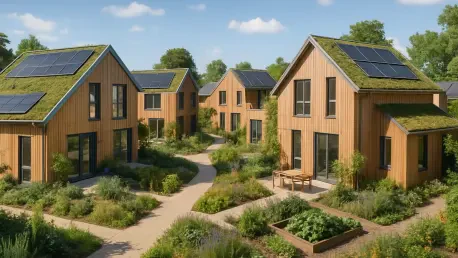In a world grappling with the dual crises of climate change and a burgeoning population, the urgent need for sustainable housing has never been more apparent, as urban centers swell and environmental degradation accelerates at an alarming pace. With millions facing housing shortages and the construction industry contributing significantly to global carbon emissions, sustainable housing emerges as a critical solution to mitigate ecological impact while meeting societal demands. This analysis delves into the evolving landscape of sustainable housing, exploring current trends, showcasing real-world applications, gathering insights from industry leaders, and considering future prospects alongside actionable strategies for stakeholders.
The Rise of Sustainable Housing: A Growing Imperative
Current Trends and Statistics in Sustainable Housing
The demand for sustainable housing is witnessing unprecedented growth, driven by heightened awareness of environmental challenges and supportive government policies. According to the World Green Building Council, the global green building sector has seen a steady rise, with certifications for energy-efficient structures increasing by over 20% annually in many regions since 2025. This surge reflects a shift toward eco-friendly materials like recycled steel and low-carbon concrete, alongside designs prioritizing energy efficiency.
Moreover, national and local policies are playing a pivotal role in accelerating adoption. Many governments now offer incentives for developers to incorporate renewable energy sources and meet stringent environmental standards, pushing the industry toward greener practices. Reports from housing authorities indicate that nearly 30% of new constructions in developed nations adhere to sustainability benchmarks, a clear sign of the sector’s transformation.
This trend is further fueled by consumer preferences, as homebuyers increasingly seek residences that reduce utility costs and environmental footprints. The integration of smart technologies for energy management and water conservation is becoming standard, signaling a broader cultural shift toward sustainability in living spaces.
Real-World Examples of Sustainable Housing Initiatives
A prime example of sustainable housing in action is The Hill Group’s development on Parsonage Road in Takeley, Essex, where 108 homes are being built with a strong emphasis on environmental responsibility. This project, featuring 40% affordable housing, incorporates energy-efficient construction, air-source heat pumps, and electric vehicle charging points, demonstrating a commitment to reducing carbon emissions while addressing local housing needs.
Beyond Takeley, The Hill Group has spearheaded other notable initiatives, such as Hollymead Square in Newport and Kennel Lane in Billericay, both in Essex. These developments prioritize design-focused, sustainable communities, integrating cycle storage and shared outdoor spaces to foster eco-conscious living. Each project reflects a meticulous approach to blending modern amenities with environmental stewardship.
These case studies highlight how developers can balance affordability with sustainability, creating models that other regions can emulate. By adapting plans to local demands—such as revising a care home proposal into additional housing in Takeley—The Hill Group showcases flexibility and responsiveness, setting a benchmark for the industry.
Industry Insights on Sustainable Housing Development
Valuable perspectives from industry leaders shed light on the strategic importance of sustainable housing. Andy Hill OBE, founder and Group Chief Executive of The Hill Group, emphasizes aligning projects with local needs while embedding sustainability at the core of development goals. His vision underscores the necessity of collaboration with stakeholders to enhance community value through thoughtful planning.
Additionally, green building experts point to persistent challenges, such as the high upfront costs of eco-friendly materials and technologies, which can deter smaller developers from adopting sustainable practices. However, they also highlight the long-term benefits, including reduced operational costs and improved resident well-being, as compelling reasons to overcome these barriers.
Thought leaders in the field stress that sustainable housing can transform urban landscapes by minimizing environmental impact and fostering resilient communities. Their consensus is clear: while obstacles like regulatory complexity remain, the potential for positive change—both socially and ecologically—makes this a priority for the construction sector.
Future Prospects for Sustainable Housing Strategies
Looking ahead, the trajectory of sustainable housing appears promising, with innovations like modular construction and net-zero energy homes poised to redefine industry standards. Modular techniques, which allow for off-site assembly, promise to cut waste and construction time, while net-zero designs aim to eliminate carbon footprints through advanced insulation and renewable energy integration.
The broader implications of these advancements extend beyond housing, influencing urban planning by promoting denser, more efficient cities with reduced environmental strain. However, challenges such as regulatory hurdles and the need to ensure affordability for diverse income groups could slow progress if not addressed through collaborative policy-making.
Adaptive planning, as exemplified by The Hill Group’s approach in revising development plans to meet current demands, may shape future projects by balancing innovation with practicality. While this flexibility offers significant benefits in addressing housing shortages, it also raises concerns about overdevelopment or community pushback, necessitating careful management to maintain positive outcomes.
Key Takeaways and Next Steps
Reflecting on the journey of sustainable housing, key trends have emerged over recent years, from the rising adoption of green certifications to impactful projects like those led by The Hill Group, which demonstrate the power of integrating affordability with eco-friendly design. The future, though filled with potential through technological advancements, faces hurdles that demand attention.
Moving forward, stakeholders must prioritize innovative financing models to offset initial costs, ensuring sustainable housing becomes accessible to all. Developers and policymakers are urged to collaborate on streamlined regulations that encourage green practices without compromising project feasibility.
Ultimately, the push for sustainable housing stands as a cornerstone for addressing the environmental and societal challenges of the era. By investing in community-focused planning and scalable eco-strategies, the industry can pave the way for resilient, inclusive urban futures, leaving a lasting legacy for generations to come.









